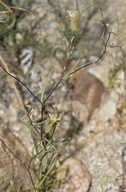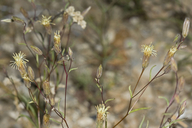|
|
click photo for larger file
high resolution: ZOOM browser
view full size

Malperia tenuis
Brown Turbans
|
Photographer: Aaron Schusteff
ID: 0000 0000 0320 0239 (2020-03-13)Copyright © 2020 Aaron Schusteff
|
|
INFORMATION PROVIDED WITH THE PHOTO
|
|
date of photo Mar 3, 2020
location
Carrizo Creek, south of Bow WIllow Road (San Diego County, California, US)family
Asteraceae
notes Near dusk our botanical field study group, organized by Tom Chester, was being led by Walt Fidler to our last destination for the day to look for the evening-opening flowers of Linanthus jonesii. But as we made our way up the rocky slope, we began to notice many subtle plants of another inconspicuous species, Malperia tenuis. At first these plants all appeared to be in bud...but then we noticed a few in 'full flower'. The term 'full flower' here merits some clarification. Malperia is a monotypic genus thought to be phylogenetically basal within the tribe Eupatorieae of Asteraceae. Like other members of that tribe, the flower heads are discoid and have narrowly-cylindric disc flowers with relatively long corolla tubes terminating in 5 short-triangular apical lobes. However, the disc flowers themselves are fairly pale & inconspicuous here, and are mostly hidden behind the phyllaries of the flower head. But in the final stage of anthesis the 2-branched styles of each disc flower fully-elongate and become conspicuously exerted beyond the apical opening of the corolla tube, from which they dangle down. At that point (i.e. 'full flower') the unusually long (compared to most other Asteraceae), paired, and slightly apically-swollen style appendages appear relatively ''showy''. As Tom noted with enthusiasm, it seemed that we were seeing more and more Malperia with long-exerted style pairs as dusk progressed and that...like the Linanthus jonesii whose flowers we had originally sought to find opening at dusk...perhaps Malperia tenuis was also an 'evening blooming' species? I've been searching for detailed info on flowering and pollination for Malperia tenuis...but so far have been unable to find anything relating to the hypothesis of 'evening flowering' for this (relatively rare & little-known or studied) species. [For some references, here are links to Sereno Watson's original 1888 description, a 1967 treatment by King, and the most detailed account I could find: King & Robinson(1987).] I'm not sure what selective pressures might give rise to 'evening flowering' for Malperia? Perhaps moth pollination? There are photos on CalPhotos and elsewhere showing fully exerted styles that appear to have been taken at times other than dusk, so our speculative hypothesis of 'evening flowering' could be mistaken...but it's an intriguing idea that would be interesting to pursue further. photo category: Plant - annual/perennial
|
MORE INFORMATION ABOUT THIS PLANT
|
| common names
Brown Turbans (photographer)
Look for Jepson Manual treatments, maps (University & Jepson Herbaria)View Calflora record for Malperia tenuisView all photos in CalPhotos of Malperia tenuis Check Google Images for Malperia tenuis |
|
The photographer's identification Malperia tenuis has not been reviewed. Click here to review or comment on the identification. |
|
Using this photo The thumbnail photo (128x192 pixels) on this page may be freely used for personal or academic purposes without prior permission under the Fair Use provisions of US copyright law as long as the photo is clearly credited with © 2020 Aaron Schusteff.
For other uses, or if you have questions, contact Aaron Schusteff arbonius2[AT]sbcglobal.net. (Replace the [AT] with the @ symbol before sending an email.) |
|
|






